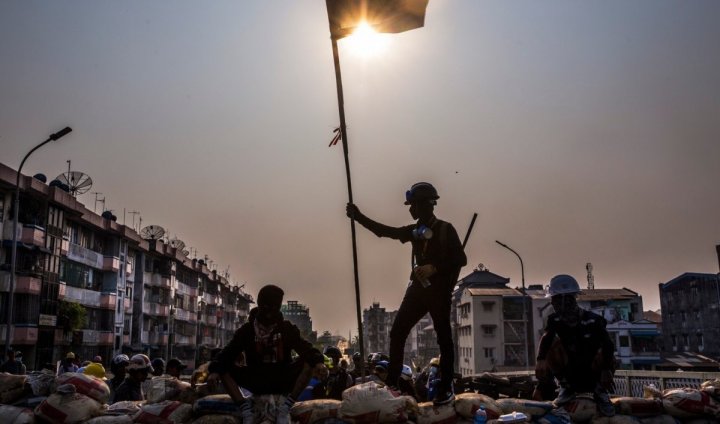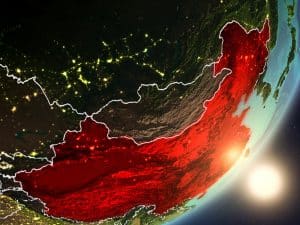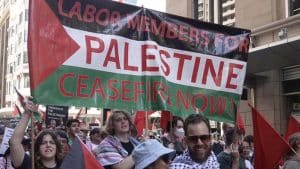From Yangon to the mountains of Shan State, resistance to Myanmar’s February 1 military coup has united a diverse coalition of the country’s ethnic groups, including armed organizations. They are protesting the repression from the Tatmadaw (as Myanmar’s armed forces are called) and fighting for greater autonomy, the overthrow of the 2008 Constitution, and the establishment of a federal (ethnic) democracy.
The images coming from this Southeast Asian country are increasingly horrifying. In two weeks the number of protesters killed has doubled — up to 600 people killed so far. Thousands have been arrested and wounded since the coup against the elected party, the National Democratic League (NLD).
The youth and workers participating in the protests, whose main demand is the fall of the dictatorship, have been radicalizing how they fight back against the repression. Huge barricades, steel shields, firecrackers, air guns, slingshots, Molotov cocktails, etc., have painted the landscape of Yangon, Mandalay, and other cities against a backdrop of incessant fighting. Many young protesters now see themselves as “warriors” and have begun to demand the fall of the 2008 Constitution that protects the army’s power.
The workers and youth resistance confronting the military increasingly see the need to organize self-defense in the face of increased repression. But faced with the possibility of a civil war the movement will need to develop an class independent leadership in order to triumph. Without that leadership, this process of revolts will be terminated, where even actors like the United States and China could intervene on one side or the other, turning the situation into a reactionary one.
The heroic popular rebellion is characterized by indefinite general strikes that have paralyzed 90 percent of port terminals, trains, and the textile industry (the economy’s main engine). Google Maps data from the end of March illustrate the strike’s impact, showing that pedestrian traffic across the country is down 85 percent from pre-pandemic data linked to recreational and commercial activities, and 80 percent for those commuting to work. The World Bank recently forecast a 10 percent contraction in Myanmar’s economy this year. Fuel and basic foodstuffs are increasingly scarce and all prices are rising, as the UN announces a humanitarian emergency.
For the regime led by Major General Min Aung Hlaing, who controls the main business agglomerates in the country, it is imperative to defeat the protest movement, which is directly threatening their profits and above all questioning the military’s power.
Consequently, with the tacit support of Russia, China, India, and Thailand, among others, the military has turned the country into a killing field: random shootings in neighborhoods, including dozens of children; organized killings in factories; arson and raids on workers’ and activists’ homes; use of weapons of war to repress; imprisonment of thousands of opponents; bombings in ethnic minority villages, etc. In addition, at least three members of the NLD (led by ousted State Counsellor Daw Aung San Suu Kyi) have been tortured to death.
In the midst of this deadly repression, many see open civil war as a possibility on the horizon. That is why hundreds of young people are seeing the need to organize self-defense. They are clandestinely training in basic warfare techniques and plotting to sabotage army installations, many of them joining ethnic armies stationed in the jungle regions.
While the focus is on anti-military protest movements in urban centers, protesters in Myanmar’s main ethnic states have also been mobilizing in opposition to military rule, waving flags with traditional symbolism.
Youth of different ethnicities have moved forward in unprecedented unity. Representing this solidarity, Karen, Chin, Kachin, and Rakhine youth established on February 11 the General Strike Committee of Nationalities (GSCN), a multiethnic protest group. Since then, representatives of 29 ethnic groups have joined the alliance. In addition, the crackdowns in towns and villages in the hinterland have been so violent and the resistance so strong that some armed ethnic groups were forced to join the resistance. They have since attacked police stations and regime outposts near their territories, saying that the killing of civilians is “unacceptable.”
Long kept out of national politics, the demands of Myanmar’s 135 ethnic minority groups (35 percent of the population) go beyond the fall of military rule: they are asking for federal democratic rights denied to them during the six decades of previous military rule and five years of NLD rule.
In 1947, shortly before Myanmar’s independence from the British Empire, the rights of the country’s ethnic minorities (at that time Burma, named after the majority ethnic group, the Bamar) had been recognized through the Panglong Agreement, negotiated by Aung San Suu Kyi’s father, General Aung San, as a condition for joining the Union of Burma. They were, however, never implemented. Since independence in 1948, at least 20 ethnic armies have been fighting against the central state in what is considered the “longest civil war in history” for autonomy.
Under the NLD government, a breakthrough toward a “Peace Process” was expected since 2016, but the clashes escalated. Immediately after the coup most of these groups did not move a muscle against the coup respecting the Ceasefire Agreement (signed with 10 armies). But more recently, some of them, including the Kachin Independence Army (KIA) and the Karen National Union (KNU), based in the eastern part of the country, announced that they stand with the people against the military dictatorship by breaking the agreement.
On March 27, the 5th Brigade of the KNU’s military wing, the Karen National Liberation Army (KNLA), seized a hilltop outpost held by the military regime in Karen State. The KNLA killed 10 soldiers, including one officer, and arrested eight soldiers as prisoners of war. In retaliation, the regime launched air strikes against the KNLA using two fighter jets in Papun District, Karen State. More than a dozen Karen were killed and thousands fled their villages in the aftermath of the subsequent airstrikes.
Some remote towns are actually at war. Fighting in Kale, Sagaing region, has continued since late March. Regime troops approaching to suppress an anti-coup protest in the town were met by villagers wielding homemade percussion firearms. Although these crude weapons were no match for the troops’ machine guns, grenades, and rocket launchers, the fight lasted for hours. Examples like this are common.
In late March, three armies encompassed in the Brotherhood Alliance warned the military that they would collaborate with other ethnic armed organizations and supporters of democracy to defend the people from the regime’s brutal repressions if the violence continued. The Arakan Army (AA), the Myanmar National Democratic Alliance Army (MNDAA), and the Ta’ang National Liberation Army (TNLA) demanded that the military junta stop its violent repression, release all civilian leaders and detainees, restore democracy, and accept the results of the 2020 general election, in which the NLD won in a landslide.
On the other hand, in early March, the National Parliament Representative Committee (NPRC) was formed, composed mostly of former NLD MPs who were elected in November. It now acts as a sort of interim government contending for international recognition. Several districts in different cities have taken over state management by forming local councils. In its attempts to win support from ethnic minority groups, the NPRC renounced the 2008 constitution and promised to build a genuine federal democracy with far-reaching autonomy for Myanmar’s ethnic states. The NPRC also issued an interim federal charter as a precursor to the drafting of a new constitution.
According to analysis by Philipp Annawitt and Moe Hteet in Nikkei Asia, “The junta’s increasingly violent crackdown is forcing CRPH leaders to move to safe territory near the Thai border and transition to armed resistance. One of the CRPH’s international envoys recently announced plans to draft a new federal constitution in the next six months and build a federal army that would include Myanmar’s ethnic armed organizations.”
Likewise, Hannah Beech’s analysis in the New York Times says that “there is a growing recognition that such efforts [by the Civil Disobedience Movement] may not be enough, that the Tatmadaw needs to be countered on its own terms. … remnants of the ousted Parliament, who consider themselves the legitimate government, said that a ‘revolution’ was needed to save the country. They have called for the formation of a federal army that respects various ethnic groups, not just the majority Bamar.”
The NLD’s maneuver seeks to capture the strength and support of ethnic armed organizations so that, in the event of a victory, it can negotiate a “post-dictatorship” government. The NLD’s objective will never be to provide rights to ethnic minorities but to reach tactical agreements with the armed organizations in the face of a common enemy. Moreover, many of them, after decades of territorial control, have turned self-determination into an empty banner, turning their operations to drug trafficking (through the famous Golden Triangle) or to attacking other ethnic groups (such as the Arakan Army against the displaced Rohingya). For the moment they discursively recognize that without these forces, they cannot seize power, and that they will have to respond to various popular demands.
Adding to the complexity of the situation is that Beijing has supported various ethnic groups in Myanmar since 1960, owing to the legacy of the Chinese Communist Party’s backing of Burma. Annawitt says China has “enormous influence” over the role played by ethnic political and armed groups in Myanmar in the current crisis. Beijing believes that it has a role to play in certain regions thanks to how close it is to the Southeast Asian country.
On this question, Shane Brady, cofounder of the group Democracy for Burma, said that Beijing was providing support to ethnic armed groups, including the KIA. He added that it is “too soon to determine whether China would become involved in the Myanmar crisis in such a way that it would be considered a proxy conflict.” Brady added that “China is likely to switch sides if the country continues its descent into chaos, damaging Chinese economic interests and causing an influx of refugees into China.”
As Myanmar is a key country in China’s geostrategy, Beijing’s current policy shows that the country is willing to support whoever manages to stabilize the ongoing crisis in Myanmar, from the Tatmadaw to the NLD (which had cultivated good relations with China during its years in power).
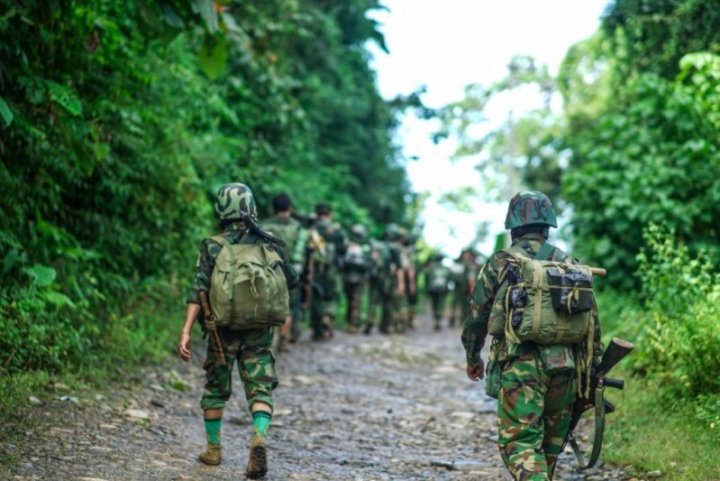
At the same time, two other questions may define the evolution of current events in Myanmar. On the one hand, before the coup, many Bamar (the country’s majority ethnic group) supported Aung San Suu Kyi without criticizing or examining her policies toward ethnic minorities. The accelerated experience of violence and oppression at the hands of the Tatmadaw has brought a new sense of solidarity with other ethnic groups who have suffered from the brutality of the military for seven decades.
“In the past, mainland Bamar people didn’t really understand why ethnic people were fighting against the military,” said Kaw Ring, a displaced person in Mai Ja Yang. “Now, many young [Bamar] people have come to understand and empathize with what other ethnic people have been going through.” In this sense, as Phillipe Alcoy says, “All this is indicating that the coup d’état and especially the resistance of youth, workers, and the popular classes in general in the big cities and urban centers, seem to be having an effect on the struggle for self-determination of oppressed ethnic minorities and thus on some of their organizations.”
On the other hand, many members of Myanmar’s ethnic minorities (about 35 percent of the population), despite their political support for the NLD, acknowledge being mired in poverty, economic isolation, and armed conflict. They had hoped that after the 2015 election victory of the NLD, the situation would change, which is why many of the ethnic state protesters say they are protesting for true federal democracy, including a new constitution that would better protect and promote ethnic rights. Vantha Hlei, a 28-year-old laborer living in the Chin State capital of Hakha, said that “the NLD government did not do enough to develop her state, the poorest in the country, while in power.”
These two tendencies, if they manage to converge, could profoundly challenge the leadership of the NLD-led movement to overcome ethnic differences. The only way out for the youth and workers of Myanmar is through a reliance on their own strength to achieve the revolutionary overthrow of the Tatmadaw by building their own revolutionary organizations, developing self-defense outside the reactionary armed groups, and displacing the NLD from any interim government post.
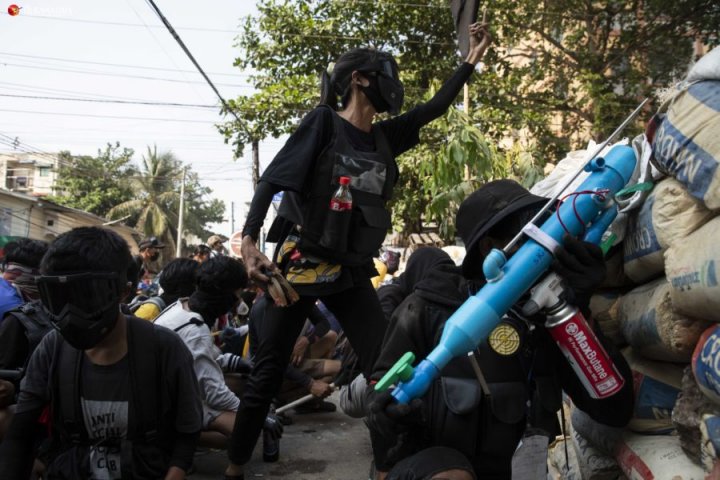
Undoubtedly, the emergence of armed groups will lead to violent clashes in the coming months. Though the Tatmadaw are militarily stronger, their morale has not been tested, and they could collapse under the pressure of the protests. The youth, on the other hand, are defiant and have the morale of a mass movement which so far has only grown stronger day after day.
The protestors are also undergoing an experience with the NLD, which has not lifted a finger in favor of the ethnic minorities in its years of rule and had maintained a coalition with the military. Faced with the possibility of a civil war, a break with the NLD becomes even more imperative for the protestors.
The struggle in its current stage leaves little room for the military to win back the loyalty of the masses. Thus, civil war and urban conflicts seem to be a catastrophic possibility. Although fighting has been confined mainly to remote, border, or rural areas, it could soon spill over into urban settings. Not only could civil war spread inland from the borders, but urban warfare could erupt within cities. This very possibility could open the door to intervention by imperialist and regional powers such as the U.S. (as we saw in Syria and Libya in 2011) or China, which has important economic interests in the country. This would result in a reactionary scenario, ending the possibility of a revolutionary process.
You might also be interested in: From India to Myanmar: Class Struggle Erupts in South and Southeast Asia
The possibility of civil war in Myanmar increasingly raises the need for self-defense and the existence of an independent organization — both from the NLD, the ethnic guerrillas, and the imperialist powers. This must be led by the youth and the working class in alliance with the ethnic minorities to impose an agenda that responds to true democratic interests under a government of workers who have been suffering hunger and exploitation. For the moment, the experience of the oppressed and exploited in Myanmar is being watched closely by workers and youth in the entire region, who have sympathy for the struggle of the protestors.
First published on April 5 in Spanish in La Izquierda Diario.
Translation by Maryam Alaniz


